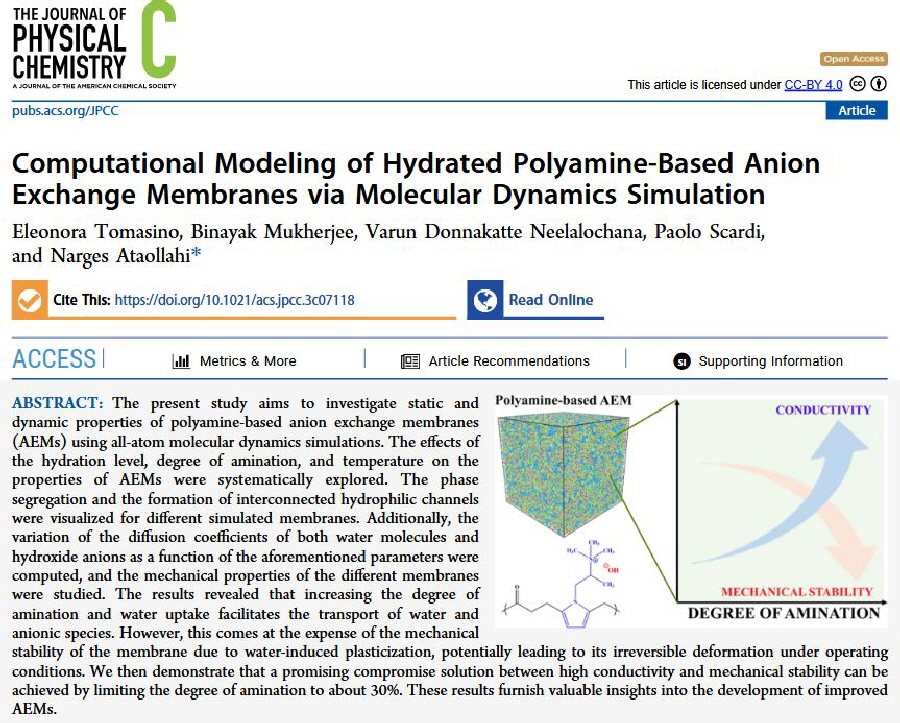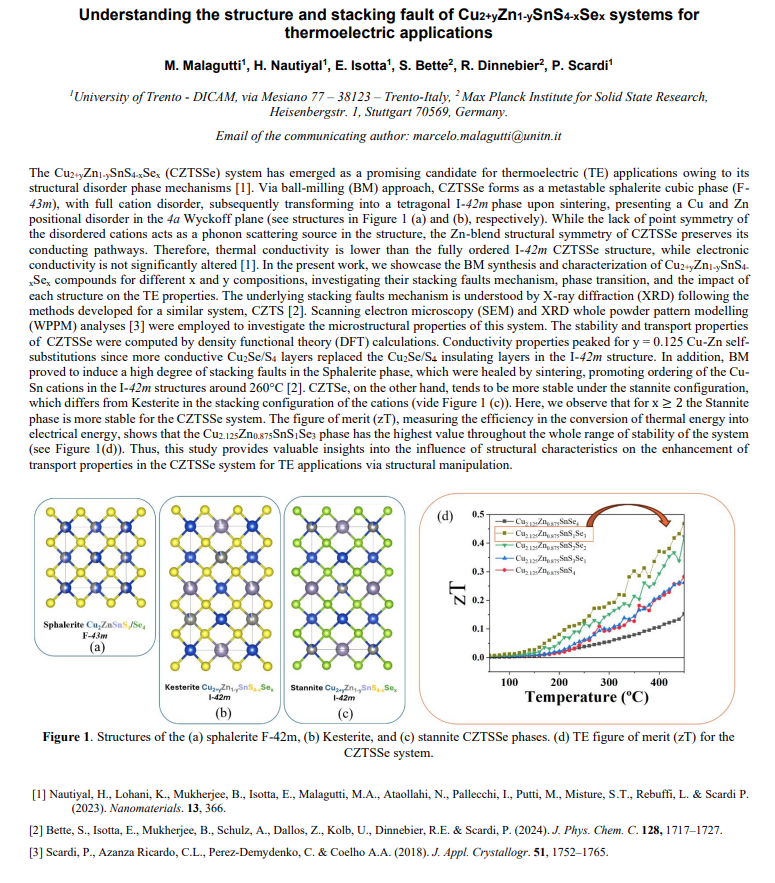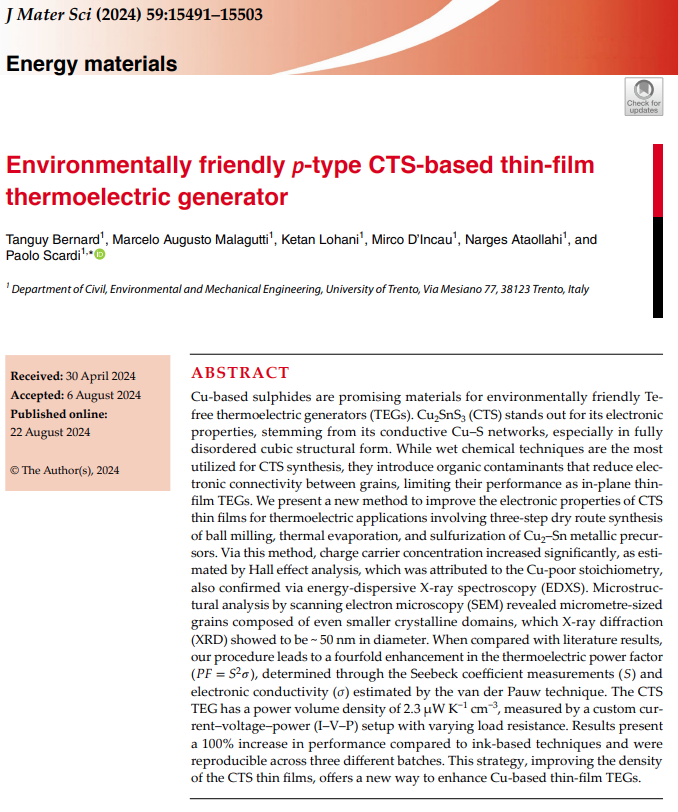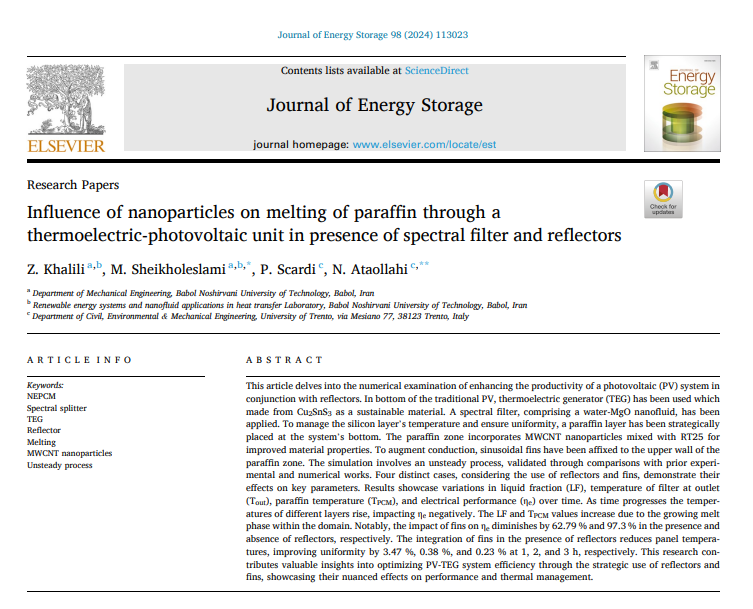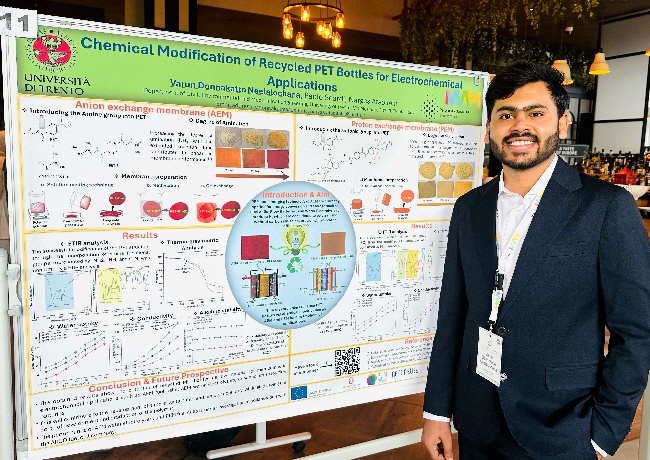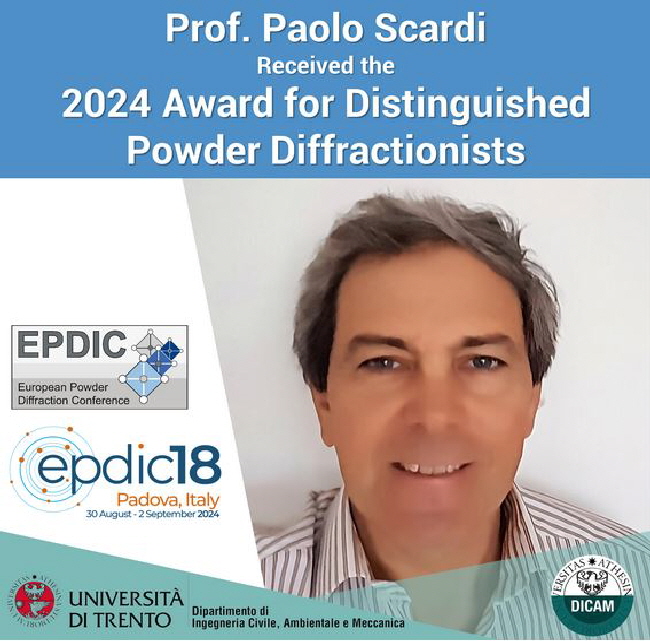NEWS: All the latest from the team
November 07, 2024
Scientific Collaboration with Fuel Cell Institute at Universiti Kebangsaan Malaysia (UKM)
We had the privilege of hosting Associate Prof. Mohd Shahbudin Masdar, Deputy Director, and Associate Prof. Rozan Mohamad Yunus from the Fuel Cell Institute at Universiti Kebangsaan Malaysia (UKM) to the Energy and Materials Group at the Department of Civil, Environmental, and Mechanical Engineering (DICAM) at the University of Trento. This visit marks the beginning of a collaborative research partnership focused on advanced materials for hydrogen production, with particular emphasis on electrolyzer and fuel cell applications.
Prof. Yunus delivered a seminar titled "Development of Advanced Electrocatalysts for Hydrogen Production". Her presentation highlighted recent advancements in electrocatalyst materials, performance optimization, and applications in Anion Exchange Membrane Water Electrolyzers. Prof. Yunus authored over 60 peer-reviewed journal articles and has a H-index of 20, underscoring her significant influence in the field. Her groundbreaking work has secured more than RM 4 million in research funding from both government and industrial grants, and she holds several patents, highlighting her innovative contributions to sustainable energy technologies.
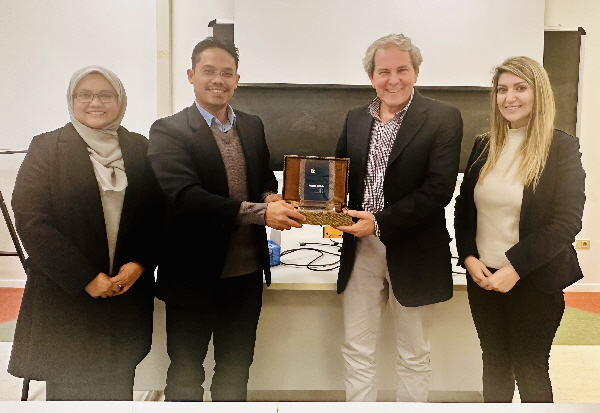
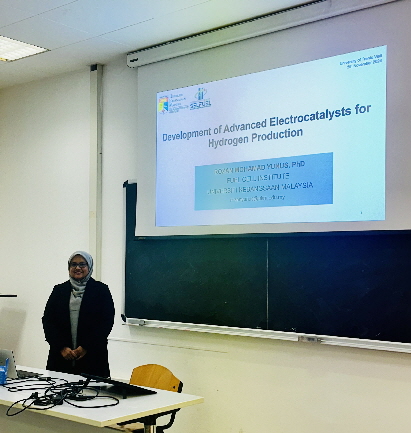
November 01, 2024
The PhD call for the topic Integrated PV-AEM Electrolyzer System for Efficient Green Hydrogen Production has closed, and the selected candidate is Sirisha Subbareddy.
October 17, 2024
CuFeS2/Cu2S/FeS2 Composite to Increase the Performance of Thin-Film Thermoelectric Generators Based on Sustainable Materials
Marcelo Augusto Malagutti, Ketan Lohani, Ivan Caño Prades, Alejandro Navarro-Güell, Tanguy Bernard, Andrea Chiappini, Edgardo Saucedo, Narges Ataollahi, and Paolo Scardi
ACS Appl. Electron. Mater.
https://doi.org/10.1021/acsaelm.4c01248
Abstract
Thermoelectric devices convert waste heat into electric energy but typically rely on scarce, expensive, and toxic Tebased materials. To address these limitations, we propose the Cu−Fe−S sulfide system as a nontoxic, abundant, and environmentally friendly alternative, with enhanced properties achieved through the synergistic behavior of CuFeS2, Cu2S, and FeS2 phases in a thinfilm thermoelectric generator. These phases were synthesized using a three-step process: ball milling, thermal evaporation, and sulfurization of Cu/Fe precursors, with the CuFeS2/Cu2S/FeS2 phase ratio being tuned by adjusting the sulfurization temperature and duration. The presence of binary sulfides enhances the electric connectivity between CuFeS2 grains, which on their own exhibit poor electrical conductivity due to the formation of isolated grains during nucleation. The composite achieved a volumetric power density of 20 μW cm−3 K−1, outperforming similar Cu-based materials such as Cu2SnS3 and Cu2ZnSnS/Se4, mainly due to its optimized phase composition, higher density, and the superior Seebeck coefficient and electrical conductivity achieved through nanoinclusion. The eco-friendly, low-cost Cu−Fe−S system, synthesized through scalable ball milling and thermal evaporation, presents a promising alternative to conventional materials for sustainable thermoelectric generation.

October 15, 2024
Contemporary Breakthroughs and Diverse Chemistry Innovations in Waterborne Polyurethane
K. L. Chai · Min Min Aung · Davin Yap Kin Yew · Mohd Sukor Su’ait · Azizan Ahmad · Narges Ataollahi ·Lee Tian Khoon
Journal of Polymers and the Environment
https://doi.org/10.1007/s10924-024-03437-9
Abstract
Polyurethane, a hydrophobic polymer with limited water solubility, is widely employed in applications including foam insulation, adhesives, coatings, and both flexible and rigid plastics. Waterborne polyurethane (WBPU) has emerged as a focal point due to its water-dispersible nature Its beneficial qualities, such as low emissions of volatile organic compounds (VOCs), simplicity of use, and environmental friendliness, are the reason for its appeal. WBPU is recognized for being non-toxic, non-flammable, and low VOC properties so it can help prevent the pollution of air water rather than increase. Moreover, it exhibits remarkable adhesion properties to a wide range of surfaces, such as glass and polymeric fibres. These exceptional qualities of WBPU have piqued the interest of researchers worldwide. This review focuses on the fundamental principles of WBPU chemistry and explores its physical attributes. It proceeds to provide an extensive examination of various studies, shedding light on the reaction procedures and mechanisms involved. Additionally, the article delves into the modifications introduced in the production process, the selection of source materials, and associated limitations.
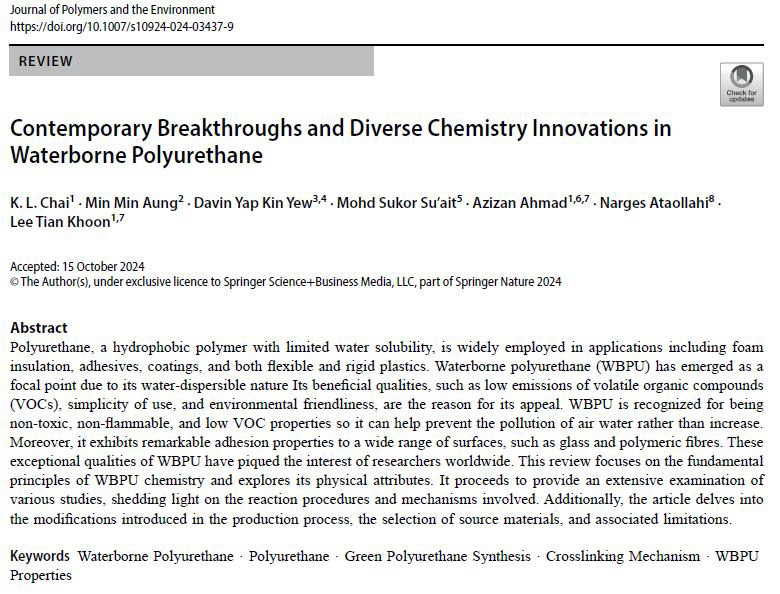
October 09, 2024
Unraveling the structural and thermoelectric properties of the Sn-doped filled skutterudite Smy(FexNi1-x)Sb11.5Sn0.5 (y = 0.17–0.34, x = 0.43–0.64)
Cecilia Piscino, Giovanna Latronico, Pietro Manfrinetti, Nadia Parodi, Roberto Spotorno, Carlo Fanciulli, Ketan Lohani, Tanguy Bernard, Paolo Scardi, Paolo Mele, Cristina Artini
Journal of Alloys and Compounds 1009 (2024) 176966
https://doi.org/10.1016/j.jallcom.2024.176966
Abstract
A systematic study of the filled skutterudite system Smy(FexNi1-x)4Sb11.5Sn0.5 was carried out with the aim of investigating the effect of the partial substitution of Sb by Sn on the structural and thermoelectric properties of the material. The presence of Sn induces a shift of the p/n crossover toward lower values of x compared to the corresponding Sn-free system, as a consequence of the smaller number of electrons supplied. Moreover, a discontinuity at the p/n crossover is observed in the cell parameter and related structural features. The thermoelectric properties suggest lower thermal conductivity values in comparison to similar Sn-free skutterudite systems, resulting in higher ZT. This result highlights the significant role of Sn in creating new scattering centers
able to affect the phonon transmission through the crystal lattice.
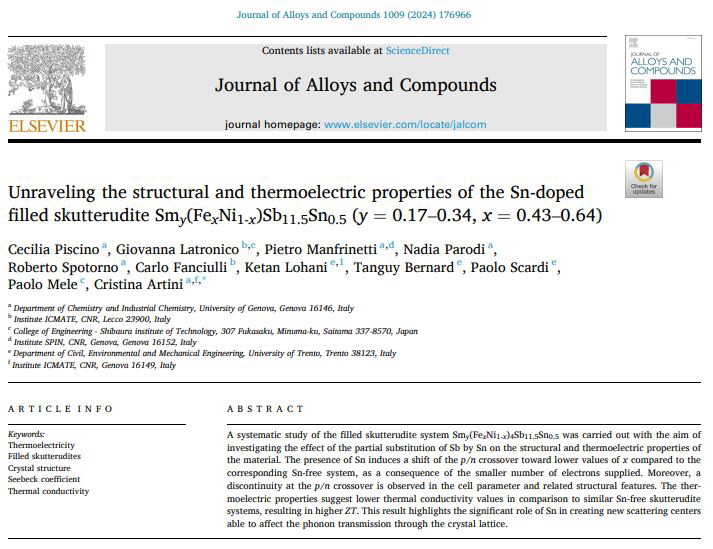
Settember 28, 2024
Impact of functionalized titanium oxide on anion exchange membranes derived from chemically modified PET bottles
Varun Donnakatte Neelalochana, Eleonora Tomasino, Marcelo Augusto Malagutti, Ines Mancini, Andrea Chiappini, Sandeep Shadakshari, Maxwell W. Terban, Bernd Hinrichsen,
Paolo Scardi, Narges Ataollahi
Electrochimica Acta 507 (2024) 145170
https://doi.org/10.1016/j.electacta.2024.145170
Abstract
The accessibility of newly affordable materials has drawn significant attention to the anion exchange membrane (AEM) technology. However, developing a high-performance AEM with excellent hydroxide conductivity and long-term durability is still challenging. The present work aims to improve the overall properties of AEMs synthesized by chemical modification of Polyethylene terephthalate (PET) bottles as the starting material. The modified PET structure was confirmed using IR, NMR, and HPLC-ESIMS analyses. AEMs were developed by incorporating quaternary ammonium (QA) functional groups into the modified PET structure, necessary for transporting anionic species (OH������ ). In addition, TiO2 nanoparticles grafted with silane coupling agents containing amine functional groups were synthesized via the sol-gel method and embedded in the polymer matrix. Then, the prepared nanocomposite membranes were thoroughly characterized, and the results displayed an overall improvement in the membrane’s physicochemical properties. The composite membrane with 3wt% content of nanoparticle (NC3 %/M-PETm) showed remarkable conductivity, reaching 126 mS/cm at 80 ◦C, doubling the value of pristine membranes (64 mS/cm) while also displaying alkaline stability, retaining up to 92.2 % of conductivity after 20 days in harsh 2 M KOH at 80 ◦C. These results proved the suitability of these membranes for electrochemical energy applications. This innovative approach offers potential cost savings in preparing the new membranes while aligning with sustainable and circular economy principles.

August 30, 2024
Congratulations to Professor Paolo Scardi!
Professor Scardi has been honored with the prestigious EPDIC Award as the "Distinguished Powder Diffractionist" at the European Powder Diffraction Conference (EPDIC 18), held in Padova from August 30 to September 2, 2024.
This international recognition highlights his significant contributions to the field of powder diffraction and represents a proud achievement for our UniTrento DICAM and the Universita’ di Trento.
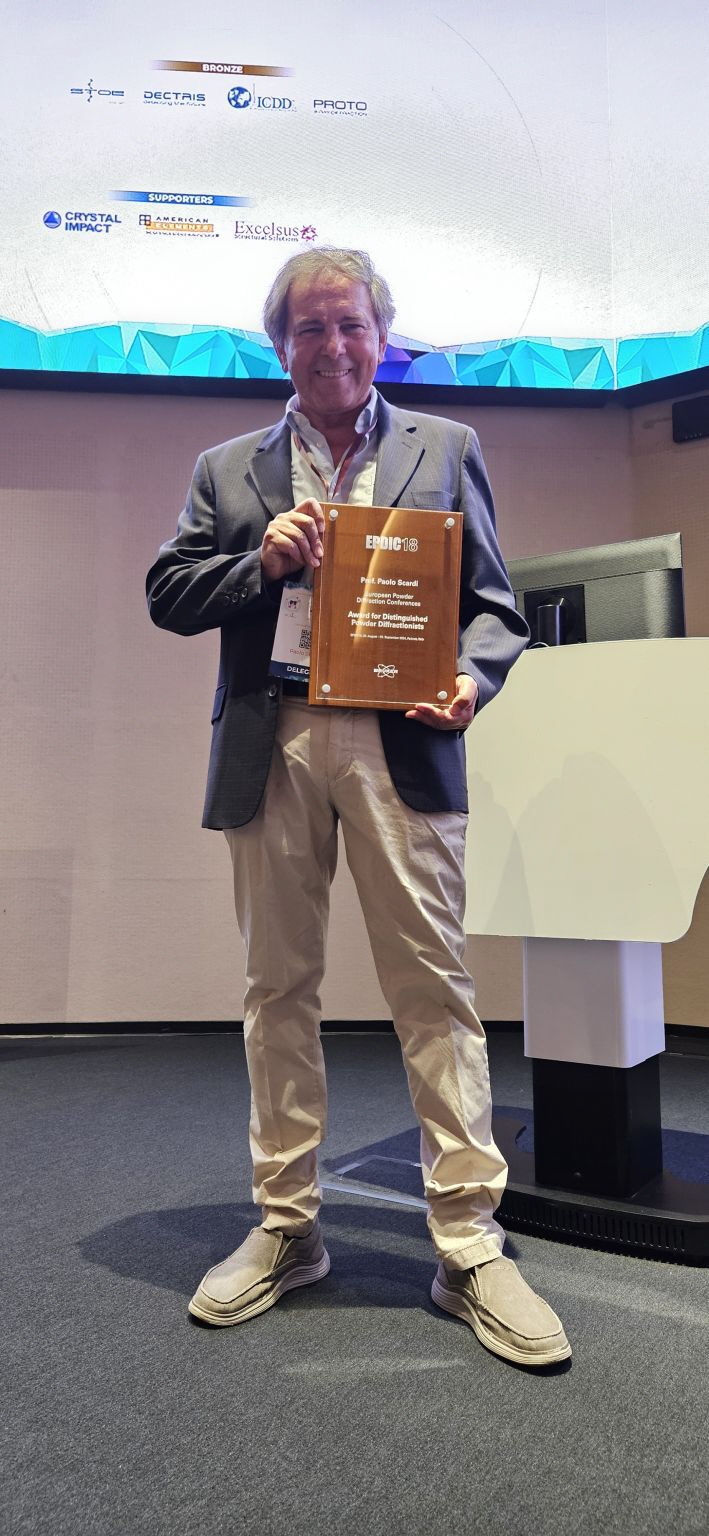
August 30, 2024
The PhD student Marcelo Malagutti delivered an oral presentation titled "Understanding the structure and stacking fault of Cu2+yZn1-ySnS4-xSex systems for thermoelectric applications" at the 18th European Powder Diffraction Conference held in Padova-Italy from August 30 to September 2, 2024. The conference is devoted to all aspects of the analysis of polycrystalline materials using diffraction methods and it serves as ideal platforms for showcasing and disseminating new developments in powder diffraction instrumentation, analysis, and applications. EPDIC conferences brings together experts from universities, research institutes and instrumentation companies to share their knowledge and discuss the current trends and challenges in powder diffraction.
August 22, 2024
Environmentally friendly p-type CTS-based thin-film thermoelectric generator
Tanguy Bernard, Marcelo Augusto Malagutti, Ketan Lohani, Mirco D’Incau, Narges Ataollahi, Paolo Scardi
J Mater Sci (2024) 59:15491–155033
htps://doi.org/10.1007/s10853-024-10104-w
Abstract
Cu-based sulphides are promising materials for environmentally friendly Tefree thermoelectric generators (TEGs). Cu2SnS3 (CTS) stands out for its electronic properties, stemming from its conductive Cu–S networks, especially in fully disordered cubic structural form. While wet chemical techniques are the most utilized for CTS synthesis, they introduce organic contaminants that reduce electronic connectivity between grains, limiting their performance as in-plane thinflm TEGs. We present a new method to improve the electronic properties of CTS thin flms for thermoelectric applications involving three-step dry route synthesis of ball milling, thermal evaporation, and sulfurization of Cu2–Sn metallic precursors. Via this method, charge carrier concentration increased signifcantly, as estimated by Hall efect analysis, which was atributed to the Cu-poor stoichiometry, also confrmed via energy-dispersive X-ray spectroscopy (EDXS). Microstructural analysis by scanning electron microscopy (SEM) revealed micrometre-sized grains composed of even smaller crystalline domains, which X-ray difraction (XRD) showed to be ~ 50 nm in diameter. When compared with literature results, our procedure leads to a fourfold enhancement in the thermoelectric power factor ( PF = S2휎 ), determined through the Seebeck coefcient measurements ( S ) and electronic conductivity (σ) estimated by the van der Pauw technique. The CTS TEG has a power volume density of 2.3 μW K−1 cm−3, measured by a custom current–voltage–power (I–V–P) setup with varying load resistance. Results present a 100% increase in performance compared to ink-based techniques and were reproducible across three diferent batches. This strategy, improving the density of the CTS thin flms, ofers a new way to enhance Cu-based thin-flm TEGs.
July 30, 2024
The PhD student Marcelo Malagutti delivered an oral presentation titled "CuFeS2 In-plane Thermoelectric Generators Produced by Ball Milling, Thermal Evaporation, and Sulfurization" at the 40th International and 20th European Conference on Thermoelectrics (ICT/ECT) held in Krakow-Poland from June 30 to July 4, 2024. The conference is a forum for discussion of new ideas and discoveries in the field of chemistry, physics and materials science, as well as practical applications in the industrial and energy sectors that contribute to the progress in thermoelectricity. The conference covered all possible aspects: theory and modelling, physical phenomena, new materials, measurement techniques, thermoelectric devices, systems and applications.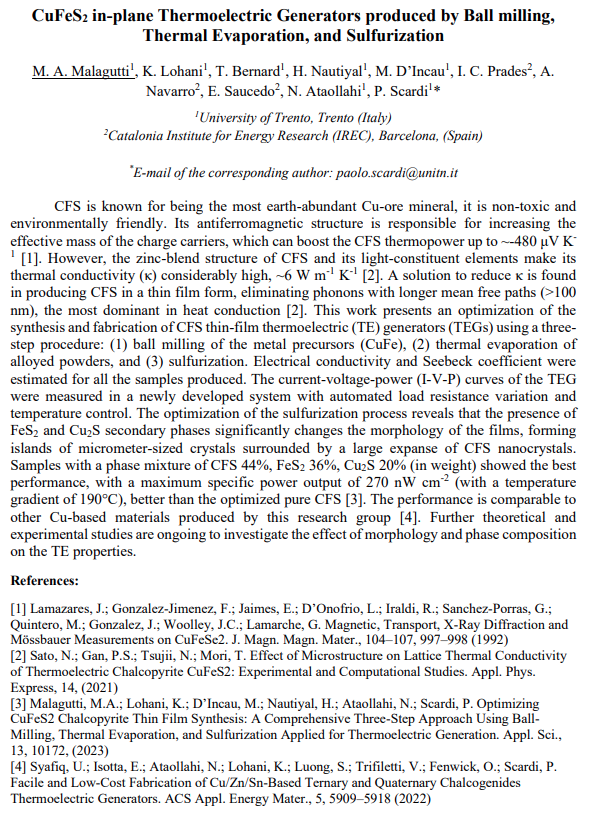
July 2024
Award and achievments
PhD Ketan Lohani was awarded the Juan de PhD Eleonora Isotta was awarded a Marie PhD Syafiq Ubaidah has awarded a research project The project is titled "Enhancing Structural and Thermoelectric Properties of Bi2Te3 via Cationic Doping for High _zT_ Thin Film." led by Syafiq from SERI-UKM, with collaboration from Narges Ataollahi at DICAM, UniTn.
 la Cierva 2023 postdoctor al fellowship. The Juan de la Cierva grants are designed to promote the integration of young researchers with a doctorate degree into Spanish research and development (R&D) centers to further their postdoctoral research training
la Cierva 2023 postdoctor al fellowship. The Juan de la Cierva grants are designed to promote the integration of young researchers with a doctorate degree into Spanish research and development (R&D) centers to further their postdoctoral research training
 Skłodowska-Curie Actions postdoctoral Fellowship, for the project: "MetaSCT: Metamaterials for Thermoelectric Applications - multiscale Structure, Chemistry, Thermal Property relations to uncover the local behavior of grain boundaries". This MSCA fellowship will fund Eleonora for two years to perform research at the Nanoanalytics and Interfaces group of Prof. Christina Scheu at the Max-Planck Institute for Sustainable Materials in Düsseldorf, Germany, and in collaboration with the group of Prof. Jeff Snyder and the group of Prof. Oluwaseyi Balogun at Northwestern University, USA.
Skłodowska-Curie Actions postdoctoral Fellowship, for the project: "MetaSCT: Metamaterials for Thermoelectric Applications - multiscale Structure, Chemistry, Thermal Property relations to uncover the local behavior of grain boundaries". This MSCA fellowship will fund Eleonora for two years to perform research at the Nanoanalytics and Interfaces group of Prof. Christina Scheu at the Max-Planck Institute for Sustainable Materials in Düsseldorf, Germany, and in collaboration with the group of Prof. Jeff Snyder and the group of Prof. Oluwaseyi Balogun at Northwestern University, USA. funded by the Fundamental Research Grant Scheme, Malaysian Ministry of Higher Education.
funded by the Fundamental Research Grant Scheme, Malaysian Ministry of Higher Education.
Congratulation
July 14, 2024
Influence of nanoparticles on melting of paraffin through a thermoelectric-photovoltaic unit in presence of spectral filter and reflectors
Z. Khalili, M. Sheikholeslami, P. Scardi, N. Ataollahi
Journal of Energy Storage 98 (2024) 113023
https://doi.org/10.1016/j.est.2024.113023
Abstract
This article delves into the numerical examination of enhancing the productivity of a photovoltaic (PV) system in conjunction with reflectors. In bottom of the traditional PV, thermoelectric generator (TEG) has been used whichmade from Cu2SnS3 as a sustainable material. A spectral filter, comprising a water-MgO nanofluid, has been applied. To manage the silicon layer’s temperature and ensure uniformity, a paraffin layer has been strategically placed at the system’s bottom. The paraffin zone incorporates MWCNT nanoparticles mixed with RT25 for
improved material properties. To augment conduction, sinusoidal fins have been affixed to the upper wall of the paraffin zone. The simulation involves an unsteady process, validated through comparisons with prior experimental and numerical works. Four distinct cases, considering the use of reflectors and fins, demonstrate their effects on key parameters. Results showcase variations in liquid fraction (LF), temperature of filter at outlet (Tout), paraffin temperature (TPCM), and electrical performance (ηe) over time. As time progresses the temperatures of different layers rise, impacting ηe negatively. The LF and TPCM values increase due to the growing melt phase within the domain. Notably, the impact of fins on ηe diminishes by 62.79 % and 97.3 % in the presence and absence of reflectors, respectively. The integration of fins in the presence of reflectors reduces panel temperatures, improving uniformity by 3.47 %, 0.38 %, and 0.23 % at 1, , and 3 h, respectively. This research contributes valuable insights into optimizing PV-TEG system efficiency through the strategic use of reflectors and fins, showcasing their nuanced effects on performance and thermal management.
July 13, 2024
Honeycomb polypore biomass-derived activated porous carbon nanosheets/graphite/nafion composite: Green and sensitive electrocatalyst for nanomolar detection of Hg2+ ions and water-splitting reactions
N. Hareesha, D.M. Soumya, Mounesh, J.G. Manjunatha, R.N. Rohit, P. Manikanta, D.N. Varun, N. Ataollahi, B.A. Thippeswamy, K. Pramoda, B.M. Nagaraja
Journal of Environmental Chemical Engineering 12 (2024) 113584
https://doi.org/10.1016/j.jece.2024.113584
Abstract
The electrochemical strategies with green electrocatalysts propose a selective, steady, and sensitive direction for the trace analytes sensing, hydrogen evolution reaction (HER), and oxygen evolution reaction (OER) applications. Herein, Honeycomb Polypore biomass waste-derived NaOH-activated porous nanocarbon material was synthesized, which performs as a multifunctional electrocatalyst for Hg2+ sensing and water-splitting reactions with the support of graphite and Nafion composite. The optimized nanocomposite shows high electrochemical activity for the redox reaction of Hg2+ in 0.1 M phosphate-buffered saline of 5.0 pH with a lower limit of detection value of 2.309 nM, good stability, reproducibility, and anti-interference activity. For water-splitting reactions, the optimized nanocomposite shows better overpotential values of 0.447 V (HER in 0.5 M H2SO4) and 0.305 V (OER in 0.5 M KOH) at 10.0 mA/cm2 of current density. Also, the lower Tafel slope values of 0.089 V/decade and 0.075 V/decade of the optimum electrocatalyst signify superior proficiency towards the HER and OER activities, respectively. These outcomes validate the materials’ excellent multifunctional activity for Hg2+ detection in different water samples and water-splitting reactions, boosting their potential for environmental safety and energy production.
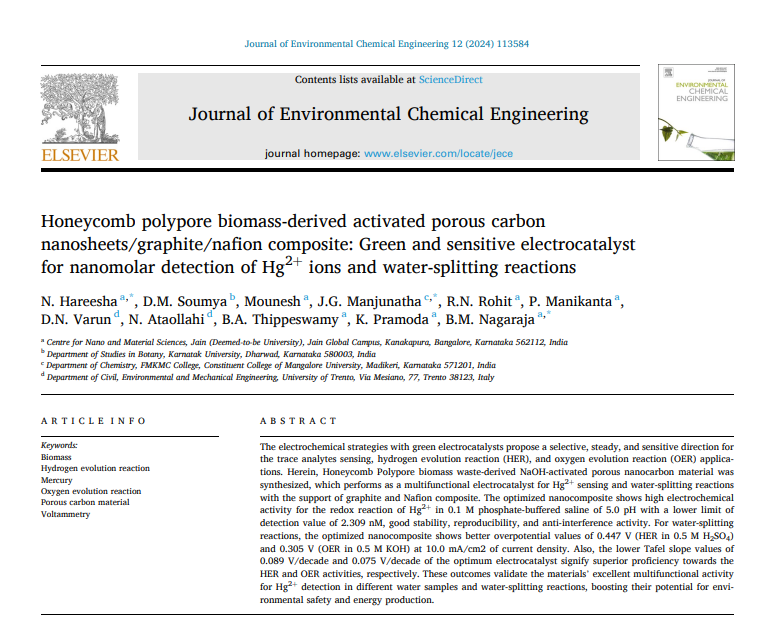
June 24, 2024
Application of Poly Dl-Phenylalanine Modified Carbon Nanotube Electrode for Sensitive and Selective Detection of Tinidazole
K. P. Moulya, J. G. Manjunatha, Ahmed M. Aljuwayid, and N. Ataollahi
ChemistrySelect 2024, 9
https://doi.org/10.1002/slct.202401843
Abstract
The present study aimed to design an electrochemical sensor for the detection of tinidazole (TN) by carbon nanotube electrode (CNTE) modified with dl-phenylalanine (DL-PA). The unmodified carbon nanotube electrode (UMCNTE) and poly (DL-PA) modified carbon nanotube electrode (P(DL-PA) MCNTE) were characterized by Scanning emission microscopy (SEM) images. Electrochemical techniques like cyclic voltammetry (CV), electrochemical impedance spectroscopy (EIS), and differential pulse voltammetry (DPV), were implemented to evaluate the efficiency of the developed electrode toward the detection of TN. The impact of pH on the modified electrode showed that the P(DL-PA) MCNTE gave a good voltammetric response at
pH 3.5. The effect of accumulation time, scan rate, and variation of concentration of TN at the surface of the developed sensor was analyzed. The scan rate study showed that the reduction reaction of TN involves a two-electron transfer process and it is adsorption-controlled. The detection limit studies for CV and DPV gave good linearity in the linear range 0.6 μM to 100.0 μM and 3.0 μM to 100.0 μM respectively. The limit of quantification (LOQ) and limit of detection (LOD) concerning CV were found to be 0.65 μM and 0.19 μM respectively. The LOQ and LOD for DPV were calculated to be 0.33 μM and 0.10 μM respectively. The P(DL-PA) MCNTE showed good anti-interferent properties. The developed sensor has good stability, repeatability, and reproducibility for the analysis of TN. The P(DL-PA) MCNTE was successfully employed in the real sample analysis.
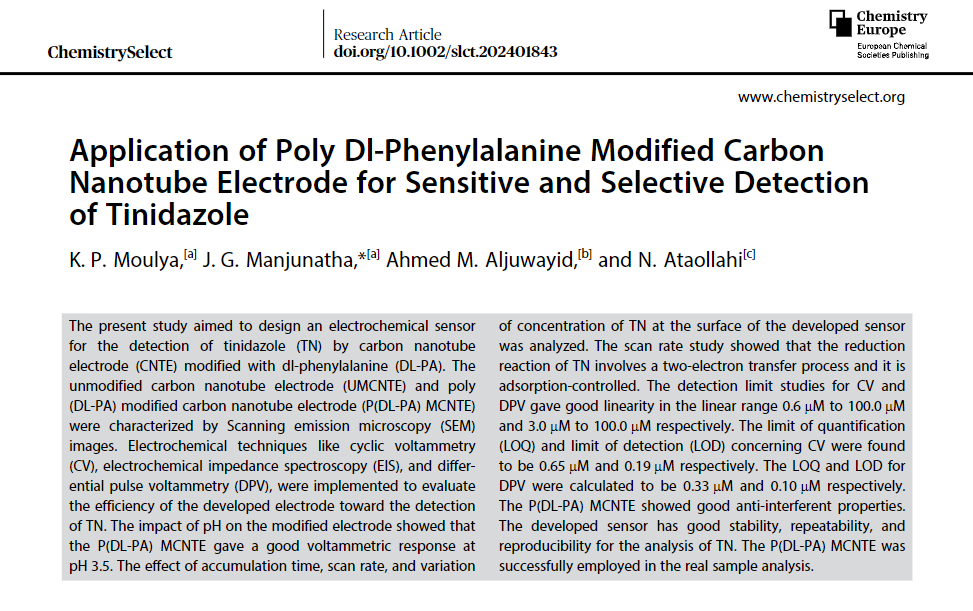
June 13, 2024
Inaugural Lecture by Prof. David Dodoo-Arhin
The next Inaugural Lecture for 2023/2024 Academic year will be delivered by Prof. David Dodoo-Arhin, BSc Physics (Hons) (Cape Coast), PGDE Science Education (Cape Coast), MSc Development Finance (Ghana), PhD (Trento-Italy). Director, Institute of Applied Science and Technology, University of Ghana, Professor of Materials Science and Engineering, School of Engineering Sciences, University of Ghana.
Topic - Beyond The Limit: Engineering Sustainable Solutions for Basic Human Needstract
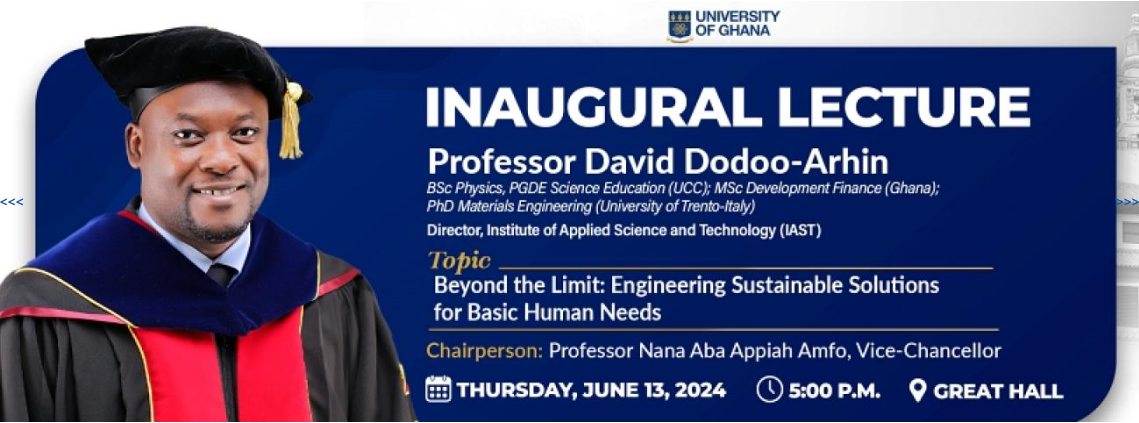
June 10, 2024
Electrochemical Analysis of Fast Sulphon Black F Using Poly(L Tyrosine)-Modifed Carbon Paste Electrode
V. Ranjan, J. G. Manjunatha, D. Sumanth, Samar A. Aldossari, Saikh Mohammad, N. Ataollahi
Journal of Electronic Materials (2024) 53:4762-4772
https://doi.org/10.1007/s11664-024-11202-w
Abstract
An electrochemical approach has been employed for the selective and sensitive determination of fast sulphon black F (FSB-F) using an electrochemically polymerized L-tyrosine (L-TN)-modifed carbon paste electrode (L-TNMCPE). This modifed electrode exhibits an efective irreversible oxidation peak at a potential of 0.6180 V, with a current sensitivity of 17.88 µA in 0.2 M phosphate-bufered saline (PBS) at pH 6.5, indicating its ability to clearly detect the oxidation of FSB-F. The characterization of the L-TNMCPE and the bare carbon paste electrode (BCPE) was observed using scanning electron microscopy (SEM), electrochemical impedance spectroscopy (EIS), diferential pulse voltammetry (DPV), and cyclic voltammetry (CV). The developed sensor presents a favorable approach for simultaneously detecting FSB-F and indigo carmine (IC), while also investigating potential interference from various metals and organic compounds. Scan rate results indicate that the reaction is absorption-controlled. Additionall , various experimental aspects are examined, including the pH and concentration variation. The modifed electrode exhibits remarkable electrochemical behavior with a limit of detection (LOD) of 0.75 × 10−6 M and a limit of quantifcation (LOQ) of 2.5 × 106 M. The L-tyrosine (L-TN -modifed carbon paste electrode shows good reproducibility, repeatability, and stability.
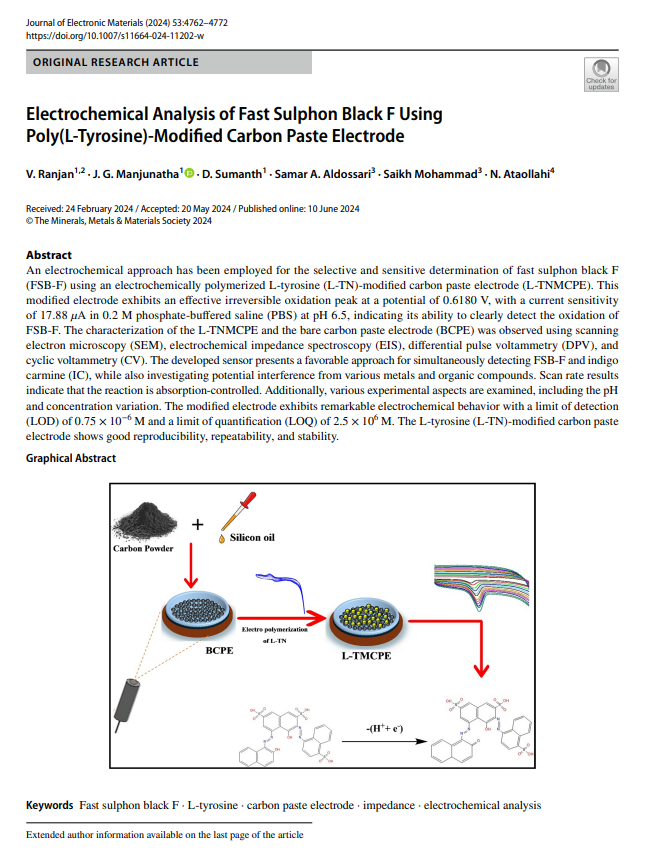
May 01, 2024
Thermoelectric properties and thermal transport in two-dimensional GaInSe3 and GaInTe3 monolayers: A first-principles study
Himanshu Nautiyal and Paolo Scardi
J. Appl. Phys.. 2024
https://doi.org/10.1063/5.0207618
Abstract
We here report the electronic structure calculation of GaInSe3 and GaInTe3 monolayers with the P3m1 (no. 156) space group. The electronic structure and thermoelectric properties of the monolayers are calculated through the Vienna Ab initio Simulation Package and BoltzTraP2 codes. The dynamic and thermodynamic stabilities were verified by calculating their phonon spectra and simulating ab initio molecular dynamics. The monolayers were found to have a direct bandgap, with both PBE + SOC and HSE06 + SOC potentials. The lattice thermal conductivity of GaInTe3 monolayer calculated using Phono3py code shows ultra-low values due to enhanced phonon–phonon scattering. Combining electrical and thermal transport, the values have been evaluated. Importantly, the p-type GaInTe3 has excellent thermoelectric properties at 700 K, with a zT value of 2, indicating that the p-type GaInTe3 has potential application in the field of thermoelectricity.
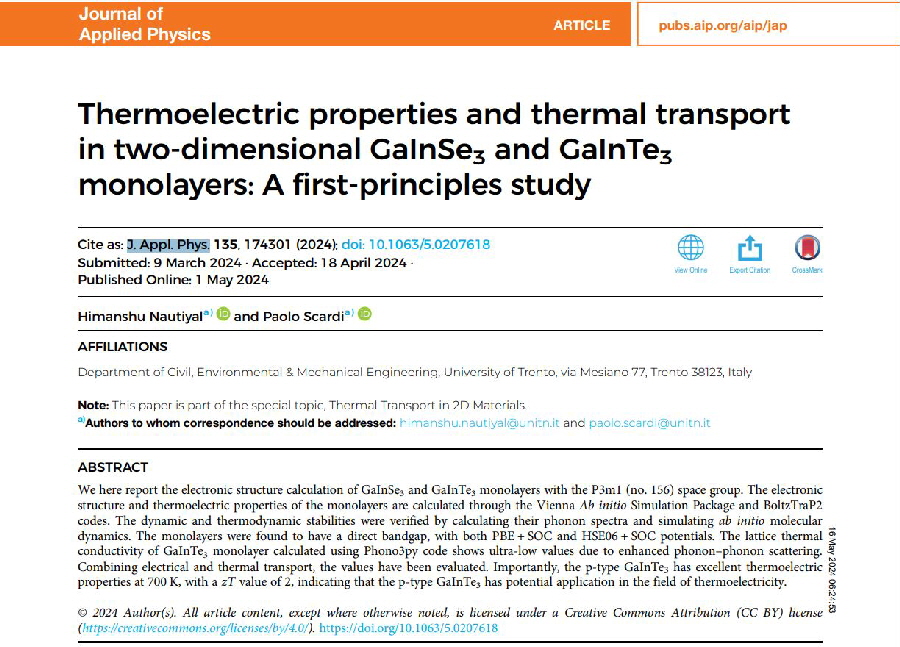
April 15, 2024
Cu2ZnSnS4-Based Electrode as an Improvement Strategy for Lithium Rechargeable Batteries: A Status Review
Maryam Hassan, Nur Imyrah, Puvaneswaran Chelvanathan, Hassan Ahmoum, Paolo Scardi, Azizan Ahmad, and Mohd Sukor Su’ait
Energy Technol. 2024, 2301173
https://doi.org/10.1002/ente.202301173
Abstract
Thermal energy storage (TES) assisted with phase change materials (PCM)sseeks greater attention to bridge the gap between energy demand and supply.PCM has its footprint toward efficient storage of solar energy. Inorganic salthydrate PCMs are propitious over organic PCMs in terms of energy storageability, thermal conductivity, andfireproof, however the major issue of super-cooling and poor optical absorbance remains. This research investigates com-mercialized inorganic salt hydrate PCM with phase transition temperature of50 °C, thermal conductivity of 0.593 W m1K which is favoured with meltingenthalpy of 190 J g1, and 2–3 °C of supercooling. Mixture of graphene: silver at aproportion of (1:1) is used as the hybrid nanomaterial to further enhance thethermal conductivity, optical absorbance, and thermal stability. Hybrid nano-composites are developed via two-step process involving direct mixing andultrasonication. Morphological behaviour, chemical stability, optical property,thermal property, thermal reliability, and stability of the developed nanocom-posite samples are experimentally analysed. As a result, sustainable TESmaterials with thermal conductivity of 0.937 W m1K, optical absorbance of 0.8,increased energy storage potential is formulated. Subsequently a numericalsimulation is conducted to illustrate the potential of the developed nanocom-posite in transfer of heat energy.RESEARCH ARTICLEwww.entechnol.deEnergy Technol.2024, 24002482400248 (1 of 13)© 2024 Wiley-VCH GmbH
April 13, 2024
A novel and efficient voltammetric sensor for the simultaneous determination of alizarin red S and tartrazine by using poly(leucine) functionalized carbon paste electrode
Karnayana Prasad Moulyaa, Jamballi G. Manjunathaa , Sameh M Osmanb, and Narges Ataollahic
JOURNAL OF ENVIRONMENTAL SCIENCE AND HEALTH, PART A 2024, VOL. 59, NO. 3, 103–112
https://doi.org/10.1080/10934529.2024.2339160
Abstract
In the current work, a rapid, selective, and sensitive technique was developed for the detection of Alizarin Red S (ARS) by applying poly leucine modified carbon paste electrode (PLMCPE). Electrochemical impedance spectroscopy (EIS) and Scanning electron microscopy (SEM) were utilized to study the surface morphology of unmodified carbon paste electrode (UMCPE) and PLMCPE. The active surface area for UMCPE and PLMCPE was found to be 0.0012 cm2 and 0.0026 cm2 respectively. The electrochemical response of ARS at UMCPE and PLMCPE was analyzed using cyclic voltammetry (CV) in the potential window of 0.4 to 1.0 V. The cyclic voltammogram obtained for varying the pH of 0.2 M phosphate buffer (PB) solution showed maximum current for he oxidation of ARS at pH 6.5. The electrochemical reaction of ARS was found to be irreversible and adsorption controlled. The effect of variation of concentration of ARS on the oxidation peak current was evaluated using CV and linear scan voltammetry (LSV). A linear relationship between the concentration variation and current was obtained in the linear range of 1.5 lM–3.5 lM and 0.2 lM–5.0 lM for CV and LSV respectively. The limit of detection (LOD) of 0.68 lM for the CV method and 0.29 lM for the LSV method was exhibited by the developed sensor. The simultaneous study of ARS along with tartrazine (TZ) showed good selectivity for ARS. The interferents of foreign molecules showed no effect on the selectivity of the electrode. The applicability of PLMCPE on real samples gave good recovery ranging from 97.46–101.2%; hence, the sensor can be utilized on real samples. The developed sensor has good stability and sensitivity.
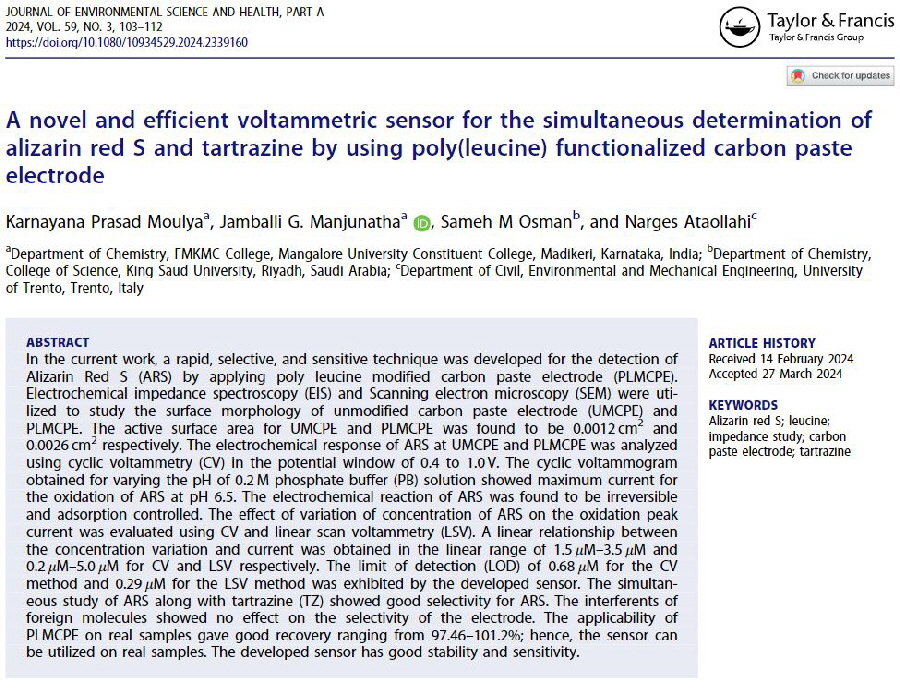
March 08, 2024
Thermal Diffuse Scattering from Nanocrystalline Systems
Paolo Scardi* and Marcelo Augusto Malagutti
Cryst. Growth Des. 2024
https://doi.org/10.1021/acs.cgd.3c01507
Abstract
The thermal diffuse scattering (TDS) in X-ray diffraction (XRD) patterns contains significant information about the local lattice dynamic structure of nanocrystalline systems. Techniques such as the pair distribution function (PDF) are commonly employed to extract this information, where the correlated movement of atomic pairs remains encoded in the breadths of the PDF peaks. However, PDF techniques require a Fourier transformation of the experimental XRD data, orientationally averaging the local dynamic information, rendering it not readily distinguishable from the static component and crystallite size and shape effects. Herein, we explore the possibility of an analysis of local lattice dynamics based directly on XRD powder pattern modeling, where TDS is added to the structural model of the traditional Rietveld method. Allied with the whole powder pattern modeling approach, the crystallite shape and static components are simultaneously estimated. Two study cases of Pd nanocrystalline systems are analyzed: (i) in silico nanosphere powder simulations via molecular dynamics (MD) and (ii) synchrotron radiation XRD powder patterns of Pd nanocubes. In silico analysis points out that the TDS model provides the correct trends of the correlated atomic movement up to the ninth coordination shell. The experimental case shows that this TDS model correctly estimates the force mechanisms of the nanocrystalline Pd system. We believe that the established method and the obtained results in this study broaden the application scope of XRD for studying the dynamic properties of nanocrystalline materials.
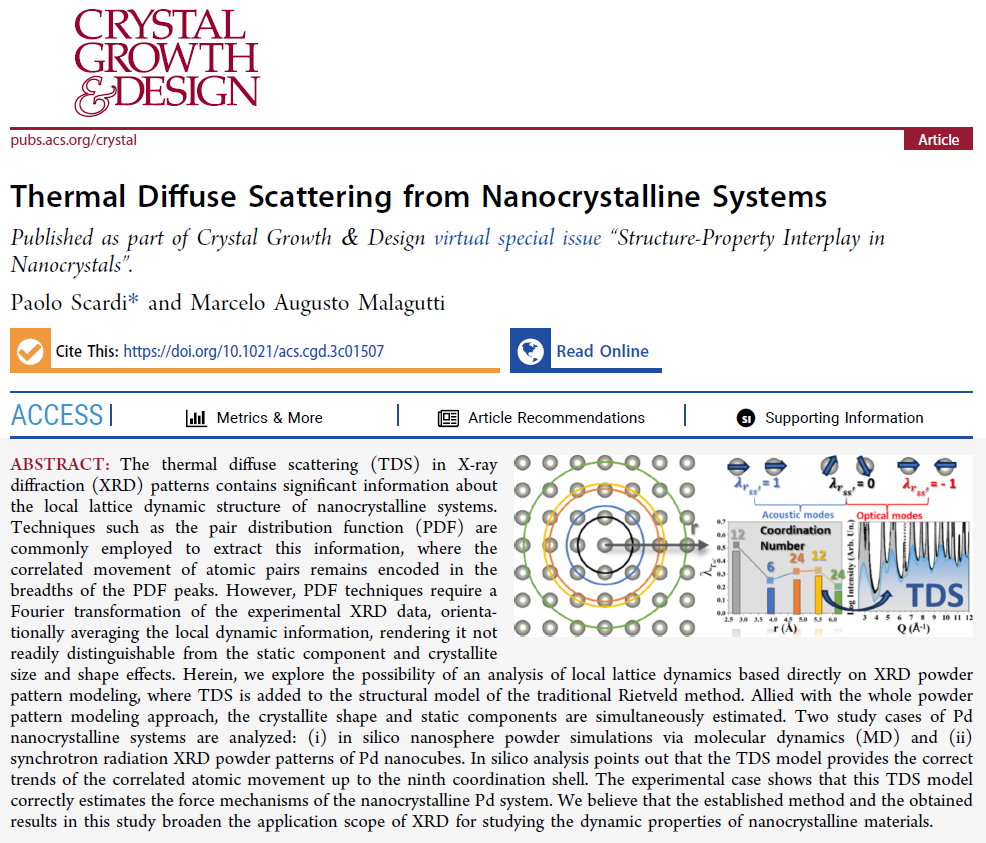
Febraury 16, 2024
Congratulations to Prof. Paolo Scardi for being honored with the 2024 Award for Distinguished Powder Diffractionists!
This prestigious recognition is a testament to Prof. Scardi's outstanding contributions to the field of microstructural investigations of materials using diffraction-based techniques overhis 40-year scientific career.
The award acknowledges Prof. Scardi's innovative methods for the analysis of peak profiles and diffuse scattering in diffraction patterns from powders and polycrystalline materials. His work has not only produced numerous applications and data modeling algorithms but has also significantly advanced our understanding of the relationships between powder diffraction and the characteristics of crystalline domains and lattice defects.
The Award will be formally presented to Prof. Paolo Scardi in Padova on 30th August 2024 during the ECM34-EPDCI18 joint event, where he will deliver the lecture titled: “40 Years of Diffraction Line Profile Analysis: from Scherrer Equation to Whole Powder Pattern Methods”.
More information at https://epdic18.org/epdic18-awards
Febraury 05, 2024
New voltammetric sensing technique for determination of paracetamol by l‑phenylalanine based carbon paste electrode
Swathi Nayak · J. G. Manjunatha · K. P. Moulya · Sameh M. Osman · N. Ataollahi
Monatshefte für Chemie - Chemical Monthly (2024) 155:155–163
https://doi.org/10.1007/s00706-024-03172-w
Abstract
In this work, the carbon paste electrode was electro-polymerized using l-phenylalanine in 0.2 M phosphate buffer solution of pH 8.0. This l-phenylalanine modified carbon paste electrode (PLPAMCPE) was used for the study of paracetamol (PCL). The modified electrode was characterized by cyclic voltammetry, differential pulse voltammetry (DPV), scanning electron microscopy, and electrochemical impedance spectroscopy. The PLPAMCPE showed an excellent current response towards the oxidation of PCL. During the pH study ranging from 5.0 to 8.0 pH, pH 6.0 showed high peak current hence considered as the optimum pH. The scan rate study showed that the reaction was adsorption-controlled reaction. Further study i.e., by varying concentration of PCL in the linear range of 1.2 μM to 12 μM, the current increases linearly. The limit of quantification of 18.2 μM and the limit of detection of 5.4 μM was obtained for the DPV method. The study also showed that the presence of different metal ions did not hinder the PCL analysis. The developed electrode showed good repeatability, stability, and reproducibility. Simultaneous study of PCL with dopamine shows good selectivity for PCL. This method is desirable due to its quickness, low cost, ease of handling, and its applicability to real sample.
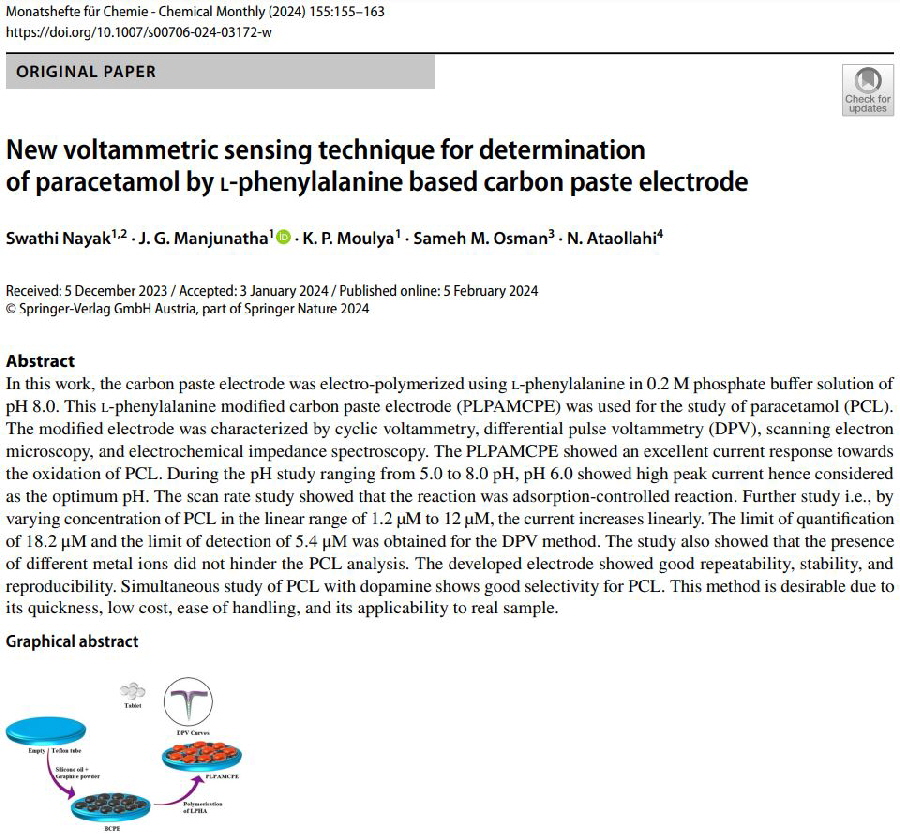
Febraury 02, 2024
Analysis of Indigo Carmine by Polymer‑Modified Biosensor Using Electro‑Polymerization TechniqueForm
B. Kanthappa · J. G. Manjunatha· N. Ataollahi · E. Taer · Z. M. Almarhoon
Journal of Electronic Materials (2024) 53:2646–2655
https://doi.org/10.1007/s11664-024-10934-z
Abstract
Indigo carmine (IC) was used as an analyte and a layer of film with serine as the functional monomer was electropolymerized to create a poly(serine)-modified carbon paste electrode (PSMCPE). Electrochemical impedance spectroscopy (EIS), scanning electron microscopy (SEM), and electrochemical technology, in that order, were used to characterize the morphology, structure, and electrochemical characteristics of the PSMCPE. Experimental parameters including the reagent molar ratio, the number of electropolymerization cycles, scan rate, and electrolyte pH level, were methodically optimized during the sensor’s fabrication. Under optimal conditions, cyclic voltammetry (CV) and differential pulsed voltammetry (DPV) were used for IC detection. The PSMCPE response current for IC exhibited a significant enhancement compared to that of the bare carbon paste electrode (BCPE). The linear range of IC measured by DPV was determined to be 0.2–3.5 μM, with the corresponding lower detection limit (LOD) 1.3211 × 10−7 M and lower limits of quantification (LOQ) 4.403 × 10−7 M. The modified electrode confirmed outstanding repeatability, reproducibility, and stability. Finally, the real-time application
of the sensor was confirmed by investigating IC in a water sample, when good IC recovery was observed.
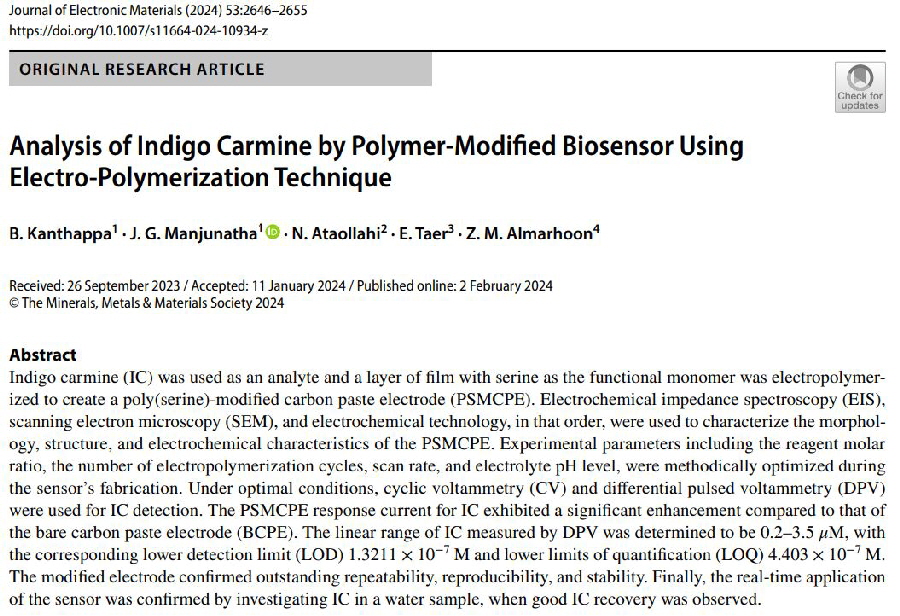
Jannuary 29, 2024
Microstructural Insights into the Transformation of Cubic, Low-Temperature, Disordered Cu2ZnSnS4 into the Tetragonal Form
S. Bette, E. Isotta, B. Mukherjee, A. Schulz, Z. Dallos, U. Kolb, Robert E. Dinnebier, and P. Scardi
J. Phys.Chem.C2024,128,1717−1727
https://doi.org/10.1021/acs.jpcc.3c07085
Abstract
Multinary earth-abundant chalcogenides, like kesterite, Cu2ZnSnS4 (CZTS), have attracted attention in sustainable energy applications like photovoltaics and thermoelectrics. Highenergy ball milling provides a facile way for the synthesis of pure cubic CZTS. This sulfide crystallizes in a sphalerite-type structure with complete occupational disorder in the cationic substructure and a considerable amount of stacking faults. Heating of the material leads to the slow and irreversible transition into disordered, tetragonal kesterite, which is associated with a significant decrease in thermoelectric properties. Hence, a deep understanding of the phase transition process and its kinetics is a prerequisite for further crystal engineering. In situ X-ray powder diffraction and Raman spectroscopy supported by density functional theory calculations and ab initio molecular dynamics simulations (AIMD) were employed to gain microstructural insights into the phase transition process. Heating leads to a growth of the crystalline domains, which is associated with a reduction of strain. The domain growth reduces the stabilization of the metastable cubic phase by nanostructuring. This eventually leads to the segregation of tin cations, which corresponds to the beginning of the transition into the tetragonal phase. AIMD simulations indicate that the presence of faulting planes promotes the tin diffusion. As stacking faults appear to be energetically less favorable in the tetragonal disordered form, the stacking fault disorder is reduced upon heating, leading to an additional strain reduction.
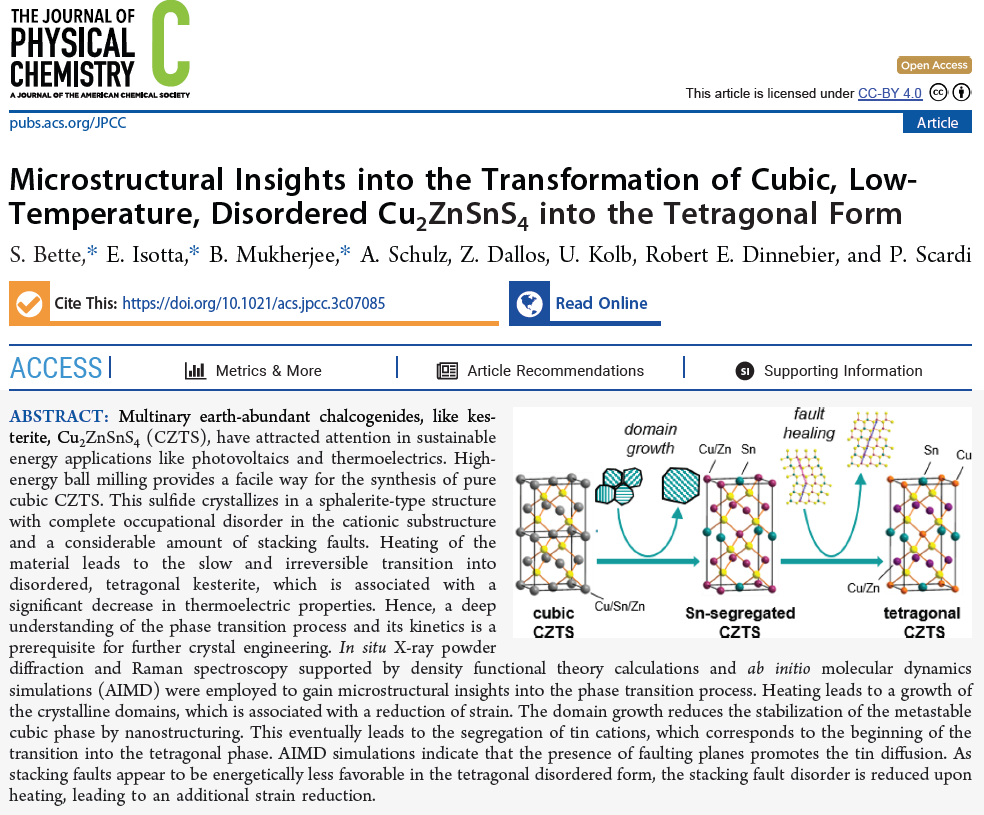
Jannuary 29, 2024
Environmental and energy assessment of photovoltaic-thermal system combined with a reflector supported by nanofluid filter and a sustainable thermoelectric generator
M. Sheikholeslami, Z. Khalili , P. Scardi , N. Ataollahi
Journal of Cleaner Production 438 (2024) 140659
https://doi.org/10.1016/j.jclepro.2024.140659
Abstract
This study focuses on new design of a photovoltaic-thermal (PVT) unit through the utilization of a cylindrical reflector. The integration of a thermoelectric generator layer fabricated from Cu2SnS3 (CTS) and a nanofluid spectral filter composed of a MgO-water mixture within PVT leads to performance enhancement. A mathematical approach was established involving optical features and the Finite volume approach was employed for simulation. The validity of the method was verified through comparison with experimental data. By introducing fins and a filter duct, along with a cylindrical reflector, the overall performance is enhanced by 36.3%. Adding a reflector into the finned structure leads to an overall performance improvement of approximately 5.7% and 4.7% with and without a nanofluid filter. By increasing the velocity of the filter, the electrical performance was enhanced resulting in an improvement of 37.7% when a reflector is present. Integrating a reflector, fins and filter in a combined system leads to the maximum reduction in CO2 emission with a value 2 times higher than that of conventional PV.
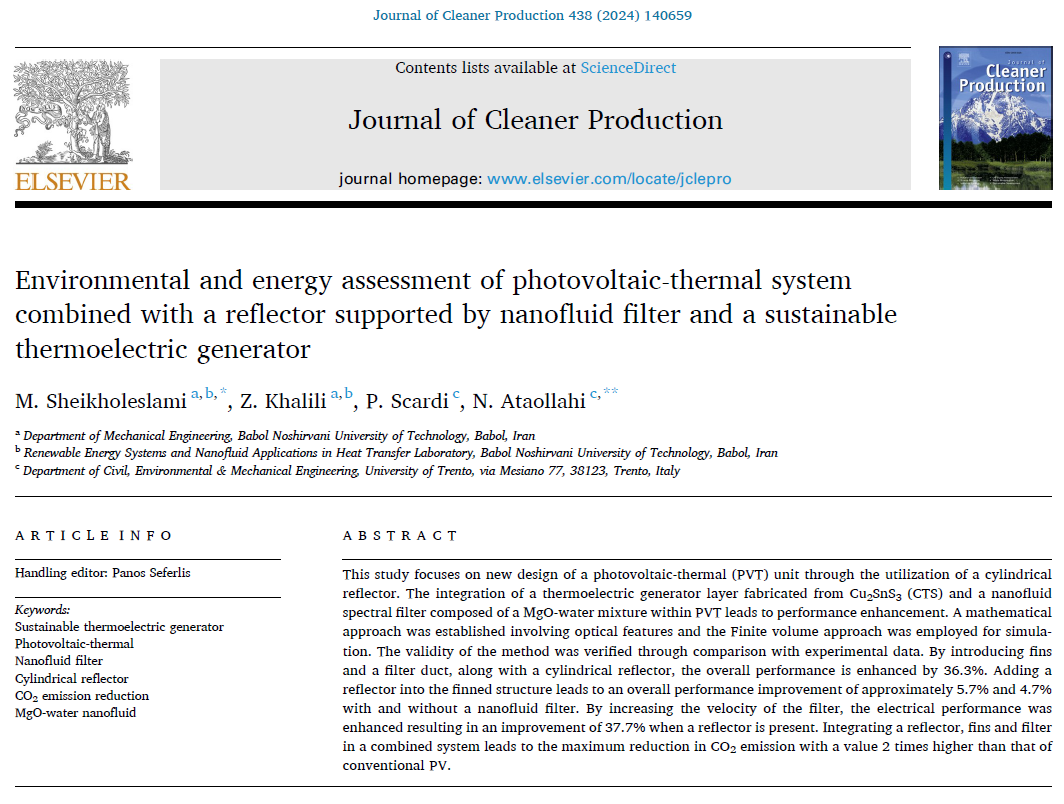
Jannuary 19, 2024
Computational Modeling of Hydrated Polyamine-Based Anion Exchange Membranes via Molecular Dynamics Simulation
Eleonora Tomasino, Binayak Mukherjee, Varun Donnakatte Neelalochana, Paolo Scardi, and Narges Ataollahi
ACS Appl.J. Phys. Chem. C. 2024
https://doi.org/10.1021/acs.jpcc.3c07118
Abstract
The present study aims to investigate static and dynamic properties of polyamine-based anion exchange membranes (AEMs) using all-atom molecular dynamics simulations. The effects of the hydration level, degree of amination, and temperature on the properties of AEMs were systematically explored. The phase segregation and the formation of interconnected hydrophilic channels were visualized for different simulated membranes. Additionally, the variation of the diffusion coefficients of both water molecules and hydroxide anions as a function of the aforementioned parameters were computed, and the mechanical properties of the different membranes were studied. The results revealed that increasing the degree of amination and water uptake facilitates the transport of water and anionic species. However, this comes at the expense of the mechanical stability of the membrane due to water-induced plasticization, potentially leading to its irreversible deformation under operating conditions. We then demonstrate that a promising compromise solution between high conductivity and mechanical stability can be achieved by limiting the degree of amination to about 30%. These results furnish valuable insights into the development of improvednology.
